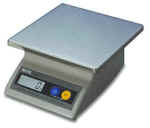
Chapter 24 Measurement: Customary Units
Measurement is a comparison that requires understanding of the attributes.
Vocabulary;
inch (in.) foot (ft.) yard (yd.) mile (mi.) estimating comparing ruler
length distance
capacity cup (c.) pint (pt.) quart (qt.) gallon (gal.)
weight ounce (oz.) pound (lb.)
Objectives;
Internet links on Measurement...
When you measure the length of an object or the distance between two object in customary units of measurement you need to decide which unit of measurement to use.
When you want to know about how long an object is you make an estimate or a visual guess. To get an accurate measurement you need to use a ruler. To make an accurate measurement you need to line up the object you want to measure with the zero mark or the start of the inch scale on your ruler. Then look at the end of the object measured and what inch of half inch mark it is the closest to on your ruler.

Try estimating the length of an object around your house or in your desk. Write down your estimate.
Now use a ruler to measure the object to the nearest inch or half inch. Were you close to the exact measurement or was your guess shorter or longer? Comparing measurements is something that we do daily... John is taller than Tom.
A ruler is like a number line. There marks between each of the numbers... 1/2 inch.
You can make a model when you need measure and compare lengths that are difficult to measure with a ruler or yardstick. For example, if you wanted to know the distance around your head so you could make a headband for your self. You could take a piece of string and wrap it around your head, and then measure the length of string.
Capacity is the amount of liquid in a container when it is filled:

When you compare capacity you look at the number of units, if you are comparing the same unit;
3 pints is _____ 5 pints ... > (Greater than) ...< (Less than) ... = equal.
If the units are not the same you need to convert the units to the same unit to compare:
3 pints is ____ 2 quarts (2 quarts equals 4 pints).
Weight is used to measure how heavy something is or what it weighs; use a scale.

When you compare weight you look at the number of units, if you are comparing the same unit;
3 ounces is _____ 5 ounces ... > (Greater than) ...< (Less than) ... = equal.
If the units are not the same you need to convert the units to the same unit to compare:
12 ounces is ____ 2 pounds (2 pounds equals 32 ounces).
Assessment:
1. What customary unit of measurement could you use to measure an object's length?
2. What customary unit of measurement could you use to measure an object's weight?
3. What customary unit of measurement could you use to measure how much liquid an object holds?
4. Can you use a rule to measure to the nearest inch an object's length?
5. Can you use a ruler to measure to the nearest half inch an object's length?
6. Can you estimate how long an object is? How much liquid it might hold? How much it might weigh?
7. Can you compare unit measurements for which is <, >, or =?
8. Can you make a model to solve a problem?